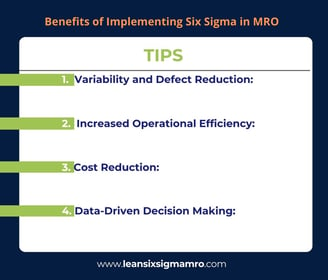Six Sigma for MRO Operations: Does it Really Work?
Six Sigma is a data-driven methodology that aims to improve the quality of processes by identifying and eliminating defects and variability. In the context of Maintenance, Repair and Operations (MRO), Six Sigma is adapted to deal with the complexity and need for precision of maintenance services.
CONCEPTS
8/6/20246 min read


Brief Overview of Six Sigma
Six Sigma is a data-driven methodology that aims to improve the quality of processes by identifying and eliminating defects and variability. Originally developed by Motorola in the 1980s and popularized by General Electric, the Six Sigma approach uses statistical tools to analyze processes and implement systematic improvements. The goal is to achieve a level of quality where fewer than 3.4 defects occur per million opportunities (DPMO).
In the context of Maintenance, Repair and Operations (MRO) operations, Six Sigma is adapted to deal with the complexity and need for precision of maintenance services. The methodology consists of five main phases, known by the acronym DMAIC: Define, Measure, Analyze, Improve and Control. Each phase has a specific set of tools and techniques that help organizations understand and optimize their processes, resulting in more efficient and lower-cost operations. The application of Six Sigma in MRO can lead to significant improvements in equipment reliability, reduced downtime and increased customer satisfaction.
Six Sigma for MRO Operations: Does it Really Work?
The Relevance of Six Sigma in MRO
The application of Six Sigma in Maintenance, Repair and Operations (MRO) is particularly relevant due to the complex and critical nature of these activities. Although the DMAIC (Define, Measure, Analyze, Improve and Control) methodology is widely recognized in manufacturing industries, its application in MRO faces unique challenges due to the non-tangibility of services and the variability of maintenance processes.
However, Six Sigma can be extremely beneficial in MRO when applied appropriately. One of the main advantages is the ability to identify and eliminate variations in maintenance processes, which results in greater consistency and predictability. This is crucial to ensuring that aircraft are always in optimal operating condition, improving inventory levels, with better predictability of materials required, minimizing downtime and increasing safety.
In addition, Six Sigma helps identify root causes of recurring problems, allowing for permanent solutions instead of temporary fixes. By applying statistical tools and data analysis techniques, MRO teams can improve operational efficiency, reducing rework costs and waste. While applying Six Sigma to MRO can be challenging, especially due to the inherent variability of maintenance services, the benefits in terms of quality and efficiency make this methodology a valuable choice for MRO operations seeking operational excellence and market competitiveness.
Benefits of Implementing Six Sigma in MRO
Implementing Six Sigma in Maintenance, Repair and Operations (MRO) operations brings a number of significant benefits. These benefits can be seen both in terms of operational efficiency and in the quality of services provided.
1. Reduction of Variability and Defects:
The main objective of Six Sigma is to reduce variability in processes, which is crucial for MRO. In aircraft maintenance operations, consistency is essential to ensure flight safety. For example, an airline that applies Six Sigma can use the DMAIC (Define, Measure, Analyze, Improve and Control) methodology to identify causes of variations in maintenance procedures and thus standardize processes, resulting in fewer defects and greater aircraft reliability.
2. Increased Operational Efficiency:
Six Sigma helps eliminate waste and optimize processes. In MRO, this can mean reducing waiting times for obtaining parts or performing repairs, increasing fleet availability. For example, by applying Value Stream Mapping, a company can identify bottlenecks and areas of waste, resulting in more agile and efficient processes.
3. Cost Reduction:
The application of Six Sigma can lead to a significant reduction in operational costs. By reducing defects and rework, companies save on materials and labor hours. A practical example would be an airline that, by using Six Sigma to improve the accuracy of engine maintenance, reduces the costs associated with unplanned repairs and maximizes the useful life of components.
4. Data-Driven Decision Making:
Six Sigma uses a data-driven approach to problem-solving and decision-making. In MRO, this means that decisions are based on detailed analysis of performance and quality data, ensuring that improvements are effective and sustainable.
Example of Applicability:
An airline can apply the Six Sigma methodology to reduce the maintenance response time of its fleet. Using tools such as Cause and Effect (Ishikawa) Diagrams and Statistical Process Control (SPC), the company can identify and eliminate the root causes of delays, resulting in a significant reduction in aircraft downtime and increased operational efficiency.


Challenges in Implementing Six Sigma in MRO
Implementing Six Sigma in Maintenance, Repair and Operations (MRO) operations can bring many benefits, but it also faces several challenges. Here, we will focus on three main obstacles: the intangibility of services, team resistance to change, and difficulties in collecting data due to low repeatability of tasks.
1. Intangibility of Services:
Unlike manufacturing, where physical products are manufactured, MRO operations deal primarily with intangible services. This makes it difficult to visualize and measure results. For example, the quality of a maintenance service can be subjective and difficult to quantify. To overcome this challenge, it is crucial to develop clear and specific performance indicators that can measure the effectiveness and efficiency of the services provided.
2. Team Resistance to Change:
Another significant challenge is team resistance to change. Implementing Six Sigma often requires changes in processes and organizational culture, which can generate discomfort and resistance on the part of employees. To mitigate this resistance, it is important to invest in training and communication. Engaging teams early on, explaining the benefits of Six Sigma and showing examples of success, can help gain the necessary support for change.
3. Difficulties in Data Collection:
MRO tasks often have low repeatability, making data collection a challenge. Each maintenance task can be unique, varying by aircraft type, component condition, and other factors. This makes it difficult to standardize and analyze data. To address this challenge, it is necessary to develop robust data collection and management systems that can capture detailed and relevant information from each operation. In addition, the use of advanced technology, such as sensors and maintenance management software, can facilitate the collection of accurate and consistent data.
Conclusion: The Applicability of Six Sigma in MRO Operations
After a comprehensive analysis of the principles and benefits of Six Sigma, as well as the specific challenges faced in its implementation in Maintenance, Repair and Operations (MRO) operations, we can draw some important conclusions about the effectiveness of this methodology.
Review of Key Points:
- Six Sigma Overview:
Data-driven methodology that aims to improve the quality of processes by eliminating defects and variability, using the DMAIC (Define, Measure, Analyze, Improve and Control) phases.
- Relevance of Six Sigma in MRO:
Crucial for standardizing processes, increasing reliability and improving safety in aircraft maintenance, despite the inherent complexities.
- Benefits of Implementation:
Reduces variability and defects, increases operational efficiency, reduces costs and facilitates data-driven decision-making. Examples show optimization of response time and accuracy in repairs.
- Challenges in Implementation:
Faces intangibility of services, resistance to change and difficulties in data collection. Strategies include developing clear metrics, training, and using advanced technologies to overcome obstacles.


Final Verdict: Does Six Sigma Work for MRO?
The answer is an emphatic “yes.” While there are challenges to implementing Six Sigma in MRO operations, the benefits far outweigh the difficulties. The methodology offers a structured, data-driven approach to improving the quality and efficiency of aircraft maintenance processes.
Six Sigma helps create more predictable and consistent operations, reducing variability and defects. It also fosters a culture of continuous improvement, where teams are encouraged to identify and resolve issues systematically. This results in improved aircraft reliability, reduced operating costs, and increased customer satisfaction.
Implementing Six Sigma in MRO can be challenging, but with the right strategy and organizational commitment, the benefits are substantial. Companies that adopt Six Sigma not only improve their processes, but also gain a competitive advantage in the marketplace. By focusing on quality and efficiency, Six Sigma proves to be a valuable tool for MRO operations, driving operational excellence and safety in the aviation industry.

Transform your MRO operations with the power of Six Sigma! Want to learn more? Explore the techniques that can revolutionize your efficiency and reduce costs. Don't miss the opportunity to deepen your knowledge with my book "Six Sigma in Aviation". Discover how to achieve operational excellence today!







